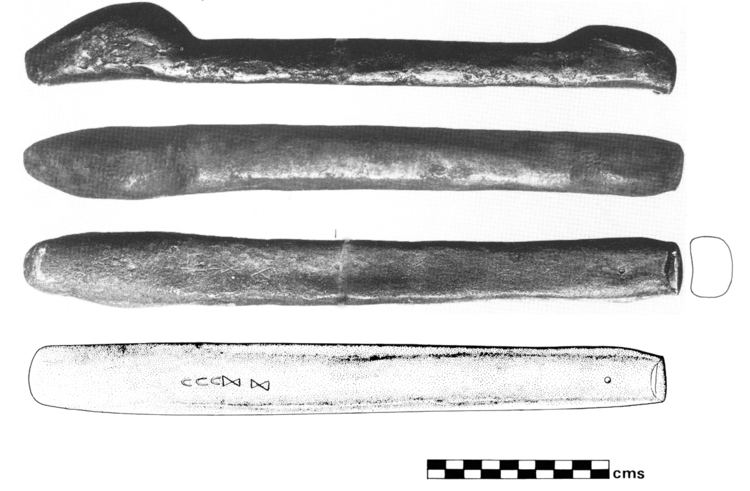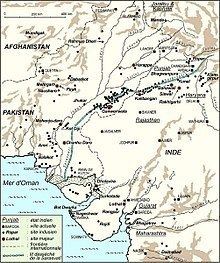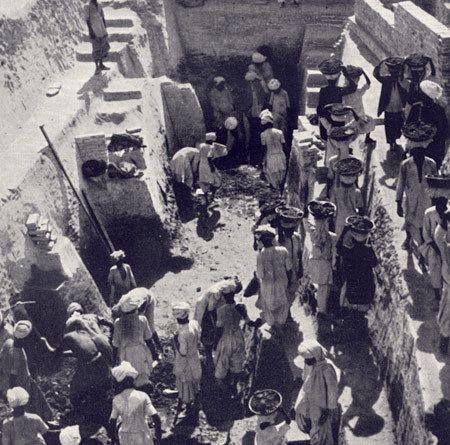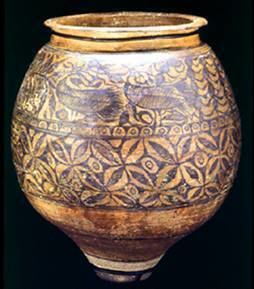Alternate name Chanhu daro Area 5 ha (12 acres) Founded 40th century BC Archaeologist Ernest J. H. Mackay | Type Settlement Abandoned 17th century BC Excavation date 1930 | |
 | ||
Periods Regionalisation Era to Harappan 4 | ||
Chanhudaro (also Chanhu Daro) is an archaeological site belonging to the post-urban Jhukar phase of Indus valley civilization. The site is located 130 kilometers (81 mi) south of Mohenjo-daro, in Sindh, Pakistan. The settlement was inhabited between 4000 and 1700 BCE, and is considered to have been a centre for manufacturing carnelian beads. This site is a group of three low mounds that excavations has shown were parts of a single settlement, approximately 5 hectares in size.
Contents
- Historical significance
- Early excavation
- Town planning
- Industrial activity
- Artifacts found
- Bead making factory
- Cultivation
- Importance
- References

Chanhudaro was first excavated by N. G. Majumdar in March, 1930 and again during winter field session of 1935-36 by the American School of Indic and Iranian Studies and the Museum of Fine Arts, Boston team led by Ernest John Henry Mackay. Prof. W. Norman Brown of the University of Pennsylvania was instrumental in enabling the funds for this project. After the independence of Pakistan, Mohammed Rafique Mughal also did exploratory work in the area.

Historical significance

Chanhudaro is one of the most important sites of Indus Civilization. More than 2500 sites belonging to Indus Civilization are identified so far and Chanhudaro is one of the bigger sites where lot of scope is identified for excavation. However, of late, excavations in this site have not been in progress leading to a decline in contributions from this site. It is situated in a desert area, but it is believed that the Sarasvati River used to flow near this site. Sarasvati river is believed to have dried up during 2nd millennium BC, causing the life at Chanhudaro and several hundreds of dwellings situated on the banks of Sarasvati to become very difficult. The people there probably had to abandon their dwelling places and it is thought that drying up of Sarasvati is one of the reasons for the decline of these dwellings, (cities and villages) which in turn contributed to the decline of Indus Civilization itself.
Early excavation

Chanhudaro is about 12 miles east of present-day Indus river bed. Chanhu-Daro was investigated in 1931 by the Indian archaeologist N. G. Majumdar. It was observed that this ancient city was very similar to Harappa and Mohenjadaro in several aspects like town planning, building layout etc.

The site was excavated in the mid-1930s by the American School of Indic and Iranian Studies and the Boston Museum of Fine Arts, where several important details of this ancient city was investigated.
Town planning

For building houses, baked bricks were used extensively at Chanhudaro and Mohenjo-daro. Several constructions were identified as workshops or industrial quarters and some of the buildings of Chanhudaro might have been warehouses.
Industrial activity

Evidence of shell working was found at Chanhudaro and bangles and ladles were made at this site. Harappan seals were made generally in bigger towns like Harappa, Mohenjadaro and Chanhudaro which were involved with administrative network.
Artifacts found
Copper knives, spears, razors, tools, axes, vessels and dishes were found, causing this site to be nicknamed the "Sheffield of India" by Earnest Mackay. Copper fish hooks were also recovered from this site. Terracotta cart models, a small terracotta bird which when blown acts as a whistle, plates and dishes were found. Male spear thrower or dancer - a broken statue (4.1 cm) is of much importance, found at Chanhudaro, is now displayed at Museum of Fine Arts, Boston, USA. Indus Seals are also found at Chanhudaro and Chanhudaro is considered as one of the centres where seals were manufactured. The scale of craft production at Chanhudaro seems much greater than that at Mohenjodaro, perhaps taking up half of town for this activity.
Bead making factory
An Impressive workshop, recognised as Bead Making Factory, was found at Chanhudaro, which included a furnace. Shell bangles, beads of many materials, stealite seals and metal works were manufactured at Chanhudaro.
Cultivation
Sesame, which is a native of South Africa, is known from number of Harappan sites, including Chanhudaro, probably grown for oil. Peas are also grown at Chanhudaro.
Importance
In respect of Indus Script, ||/ sign is only found on inscriptions found at Chanhudaro. It occurred on eleven objects, (around one sixth of all inscribed objectes recovered from Chanhudaro) leading to suggestion by Asko Parapola that it may represent town's name.
Cotton cloth traces preserved on silver or bronze objects were known from Chanhudaro, Harappa and Rakhigarhi.
Objects of Iron were reported from Chanhudaro, Ahar, Rajasthan (India) and Mundigak and this gains importance as it has been claimed that Iron was produced in 3rd Millennium in South Asia Region.
